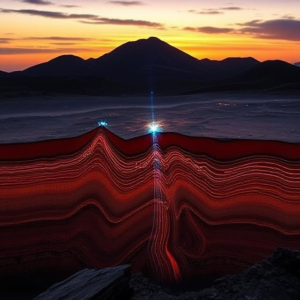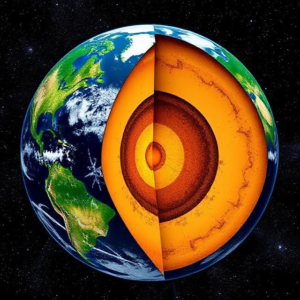Seismic Waves: What Are They?
Seismic waves are vibrations or waves that travel through the Earth. These waves are usually caused by natural events like earthquakes, volcanic eruptions, or even human activities such as explosions. They carry energy through the Earth’s interior and surface, and scientists study these waves to understand the structure of the Earth.

How Do Seismic Waves Form?
- When an earthquake occurs, it releases energy in the form of seismic waves. This energy comes from the sudden release of stress that has built up along a fault line in the Earth’s crust.
- These waves move through the Earth in different ways, depending on the type of wave and the materials they travel through.
Types of Seismic Waves
There are two main types of seismic waves: Body Waves and Surface Waves.
1. Body Waves
Body waves are seismic waves that travel through the interior (the body) of the Earth. There are two main types of body waves: P-waves and S-waves.
P-Waves (Primary Waves)
- Fastest seismic waves: P-waves are the fastest seismic waves and are usually the first to be detected by seismographs.
- Travel through solids, liquids, and gases: These waves can move through any type of material, including solid rock, liquid (like the Earth’s outer core), and gases (like air).
- Motion: P-waves move in a compressional motion, meaning they push and pull the particles of the material they are traveling through. It’s like a slinky being pushed and pulled in a straight line.
- Effect on the Earth: As P-waves pass, they cause a back-and-forth motion in the direction that the wave is traveling.
S-Waves (Secondary Waves)
- Slower than P-waves: S-waves travel more slowly than P-waves, so they arrive second on seismographs.
- Travel only through solids: S-waves can’t travel through liquids or gases, so they only move through solid material (like the Earth’s crust and mantle).
- Motion: S-waves cause a side-to-side or up-and-down motion, like shaking a rope. This motion is perpendicular to the direction in which the wave is traveling.
- Effect on the Earth: As S-waves pass, they cause the Earth to shake in a way that can cause more damage in earthquakes than P-waves.
2. Surface Waves
Surface waves travel along the Earth’s surface and are slower than body waves. However, they cause the most damage during an earthquake because their energy is concentrated at the surface. There are two main types of surface waves: Love waves and Rayleigh waves.
Love Waves
- Fastest surface wave: Love waves are faster than Rayleigh waves but slower than P- and S-waves.
- Side-to-side motion: These waves move the ground in a horizontal, side-to-side motion.
- Effect on the Earth: Love waves are very destructive because they shake the ground horizontally, which can cause buildings and structures to collapse.
Rayleigh Waves
- Rolling motion: Rayleigh waves move in a rolling or elliptical motion, much like the motion of ocean waves.
- Effect on the Earth: Rayleigh waves cause both up-and-down and side-to-side ground movement, which can be very damaging, especially near the epicenter of an earthquake.
How Seismic Waves Help Us Understand the Earth
Seismic waves provide a lot of information about the structure of the Earth. By studying how these waves travel through the Earth, scientists can figure out what the inside of the Earth is made of, even though we can’t directly observe it.
- P-Waves and S-Waves:
- P-waves can travel through both solid and liquid, but S-waves can only travel through solids. This difference helped scientists discover that the outer core of the Earth is liquid because S-waves don’t pass through it.
- Seismographs:
- Scientists use instruments called seismographs to detect and record seismic waves. The data from seismographs can tell scientists how far away an earthquake occurred and how strong it was.
Seismic waves are essential in earthquake studies because they help scientists understand the interior structure of the Earth. When seismic waves travel through the Earth, they change speed and direction depending on the type of material they encounter. By analyzing how the waves behave, scientists can figure out what the Earth is made of, even though we can’t directly observe the inside.
Key Information from Seismic Waves:
- Earth’s Layers: Seismic waves move at different speeds through solid rock, liquids, and gases. This helps scientists identify the layers inside the Earth, like the crust, mantle, outer core (liquid), and inner core (solid).
- Earthquake Location: Seismic waves also allow scientists to pinpoint where an earthquake occurred. The time it takes for the waves to travel from the earthquake’s epicenter (the surface location directly above the earthquake) to different seismographs can help locate the epicenter.
How Do We Calculate Seismic Waves?
Scientists use seismographs to detect and measure seismic waves. A seismograph is an instrument that records the motion of the ground caused by seismic waves. These machines measure the arrival times of different types of waves, which helps to calculate the earthquake’s location and magnitude.
Key Steps in Calculating Seismic Waves:
- Detecting Arrival Times:
- When an earthquake occurs, the seismic waves travel at different speeds.
- P-waves are the fastest and arrive first, followed by S-waves, and finally surface waves.
- Scientists record the arrival times of these waves at different seismograph stations. The time gap between the arrival of the P-waves and S-waves helps scientists calculate the distance to the earthquake’s epicenter.
- Using the Time Difference:
- The difference in the arrival times between P-waves and S-waves at multiple locations is key.
- Since P-waves travel faster, the time difference between their arrival and the S-waves’ arrival increases as you move farther away from the earthquake’s epicenter.
- Triangulation:
- To pinpoint the location of the earthquake, scientists use data from at least three seismograph stations.
- By measuring the distance to the epicenter from each station (using the time difference between P- and S-waves), scientists create circles on a map.
- The intersection of the three circles tells them the location of the earthquake’s epicenter.
- Calculating Magnitude:
- Scientists also calculate the magnitude (or strength) of the earthquake using the amplitude (height) of seismic waves recorded by the seismograph.
- Richter Scale: One common way to measure the magnitude of an earthquake is the Richter scale, which is based on the size of the largest seismic wave recorded.
- The higher the amplitude, the stronger the earthquake.
Real-World Example: Earthquakes
- When an earthquake happens, the energy released causes seismic waves to spread out in all directions from the epicenter (the point on the Earth’s surface above where the earthquake originates).
- These waves travel through the Earth and can be detected by seismographs placed around the world. By analyzing the arrival times of different seismic waves (P-waves, S-waves, and surface waves), scientists can pinpoint the location and depth of the earthquake’s origin.
Summary
- Seismic Waves are vibrations that travel through the Earth and are caused by events like earthquakes. They help us understand the Earth’s internal structure.
- There are two main types of seismic waves: Body Waves (P-waves and S-waves) that travel through the Earth’s interior and Surface Waves (Love waves and Rayleigh waves) that move along the surface.
- P-waves are the fastest and can travel through solids, liquids, and gases, while S-waves are slower and can only travel through solids.
- Surface waves are slower and cause the most damage during earthquakes because they affect the ground at the Earth’s surface.
- Seismologists use the patterns of seismic waves to study the Earth’s layers and locate earthquake epicenters.
Seismic waves are like a “global fingerprint” for studying the Earth, and by analyzing them, scientists gain valuable insights into the planet’s structure and behavior during natural events like earthquakes.











